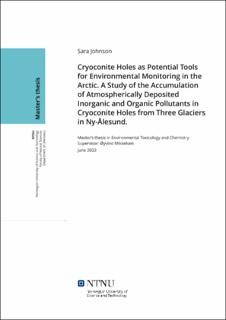| dc.description.abstract | A study of hazardous trace element accumulation in cryoconite from three glaciers in Ny-Ålesund; Austre Brøggerbreen, Vestre Brøggerbreen, and Midtre Lovénbreen, found elevated concentrations of As, Cd, and Pb compared to average upper continental crustal levels. Lead in particular was highly enriched and found to be present at ‘moderate’ levels of pollution in five of 28 cryoconite samples according to the Norwegian Environmental Agency quality standards for sediment in freshwater. Direct atmospheric deposition and scavenging of elements from replenished cryoconite hole water are likely to be the main sources for accumulation of certain elements in cryoconite. Cryoconite hole water contained a high proportion of Ca, whereas snow deposits sampled from the three glaciers were significantly elevated in Na and Cl, indicating a strong freshwater influence in the former and marine influence in the latter. Both the cryoconite and the overlying water fraction showed large spatial variability within and between the three glaciers analysed. On the whole, the spatial variation in elemental concentrations in cryoconite hole water followed the same pattern as in the cryoconite solid material, suggesting that the main source of elements detected in cryoconite hole water to be a consequence of dissolution from the solid mineral fraction. The low TOC content indicated a significant influence of the mineral fraction in the composition of cryoconite particles which was supported by a dominance of elements Al, Fe, Mg, K, and Ca. Supraglacial material from mud mound deposits on the glacier surface showed similar elemental and carbon content to cryoconite indicating that the origin of these deposits may be from melted-out cryoconite. Polychlorinated biphenyls (PCBs) were not detected in any of the cryoconite sampled, but the presence of a number of polycyclic aromatic hydrocarbons (PAHs) was observed. Given the remote situation of cryoconite holes, their limited exposure to pollutants outside of atmospheric deposition and ability to accumulate certain hazardous trace elements such as Pb and As, cryoconite could be considered an important environmental monitoring tool for changes in emissions and atmospheric transport of contaminants of concern in the Arctic. | |
